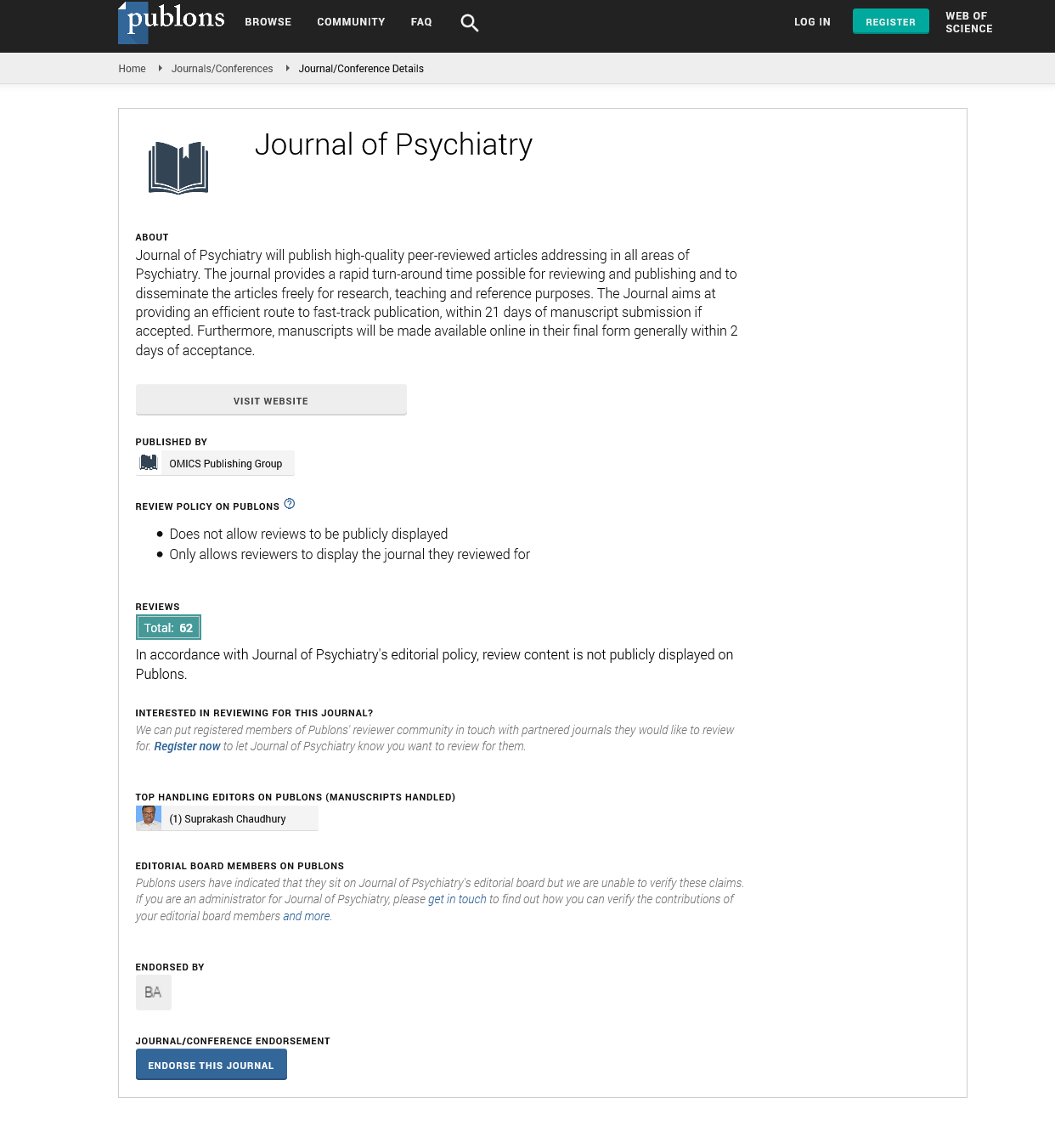Indexed In
- RefSeek
- Hamdard University
- EBSCO A-Z
- OCLC- WorldCat
- SWB online catalog
- Publons
- International committee of medical journals editors (ICMJE)
- Geneva Foundation for Medical Education and Research
Useful Links
Share This Page
Open Access Journals
- Agri and Aquaculture
- Biochemistry
- Bioinformatics & Systems Biology
- Business & Management
- Chemistry
- Clinical Sciences
- Engineering
- Food & Nutrition
- General Science
- Genetics & Molecular Biology
- Immunology & Microbiology
- Medical Sciences
- Neuroscience & Psychology
- Nursing & Health Care
- Pharmaceutical Sciences
Commentary - (2024) Volume 27, Issue 5
Evaluating the Effectiveness of Teletherapy for Mental Health during the COVID-19 Pandemic
Sofia Moudatsou*Received: 30-Aug-2024, Manuscript No. JOP-24-27407; Editor assigned: 02-Sep-2024, Pre QC No. JOP-24-27407; Reviewed: 16-Sep-2024, QC No. JOP-24-27407; Revised: 23-Oct-2024, Manuscript No. JOP-24-27407; Published: 30-Sep-2024, DOI: 10.35248/2167-0358.24.27.711
Description
The COVID-19 pandemic has had a significant impact on mental health worldwide, leading to increased rates of anxiety, depression and other psychological disorders. In response to these growing mental health needs, many healthcare providers rapidly transitioned to teletherapy defined as the delivery of therapeutic services via digital platforms to ensure continuity of care while adhering to public health guidelines. This sudden shift has prompted researchers to investigate the effectiveness of teletherapy as an alternative to traditional in-person therapy. This meta-analysis aims to synthesize existing literature on remote mental health interventions conducted during the pandemic, providing insights into their efficacy and identifying factors that may influence outcomes. Teletherapy encompasses various forms of digital communication, including video conferencing, phone calls and chat-based services. The flexibility and accessibility of these platforms have enabled therapists to reach clients who might otherwise face barriers to care, such as geographic limitations, physical disabilities, or stigma associated with seeking mental health services. As a result, teletherapy has emerged as a critical tool for maintaining mental health support during a time of unprecedented social isolation and uncertainty. This analysis will evaluate studies that compare teletherapy with traditional face-to-face therapy, assessing key outcome measures such as symptom reduction, client satisfaction and therapy engagement.
The rapid adoption of teletherapy during the pandemic has resulted in a diverse range of studies, each examining various aspects of this intervention model. Some studies focus on specific populations, such as individuals with pre-existing mental health conditions, while others assess the effectiveness of teletherapy for those experiencing acute distress related to the pandemic. This meta-analysis will incorporate a wide array of research, including randomized controlled trials, observational studies and qualitative research, to provide a comprehensive overview of the current evidence base. A critical aspect of this analysis will be the exploration of demographic factors that may influence the efficacy of teletherapy. Variables such as age, socioeconomic status and technological proficiency are likely to play significant roles in how individuals engage with and benefit from remote interventions. For example, older adults may experience challenges related to technology use, potentially impacting their ability to access teletherapy services. Conversely, younger individuals may be more comfortable with digital platforms, but may also be at higher risk for screen fatigue or distractions during sessions. By examining these demographic nuances, this metaanalysis will contribute to a deeper understanding of the populations that may benefit most from teletherapy.
Furthermore, this study will investigate the impact of different therapeutic modalities delivered via teletherapy. Cognitive- Behavioral Therapy (CBT), Dialectical Behavior Therapy (DBT) and mindfulness-based interventions have all been adapted for remote delivery during the pandemic. Comparing the effectiveness of these approaches in a teletherapy context will yield valuable insights into best practices and inform clinicians about which modalities may be most beneficial for specific client populations. Additionally, the meta-analysis will consider the role of therapeutic alliance a key predictor of positive therapy outcomes in the context of teletherapy. The establishment of trust and rapport between therapist and client is fundamental to effective therapy and the nuances of building this alliance through a screen may differ significantly from in-person interactions. Understanding how teletherapy impacts the therapeutic alliance will be essential for optimizing remote mental health services.
As teletherapy becomes an established component of mental health care, it is essential to evaluate its long-term sustainability and effectiveness. This analysis will explore whether the benefits observed during the pandemic can be maintained post- COVID-19 and what implications this has for the future of mental health treatment.
By synthesizing existing research, this study aims to inform policy decisions, funding allocations and clinical practices in the evolving landscape of mental health care. Moreover, it is important to recognize the limitations of the current body of research on teletherapy. Many studies have been conducted in specific contexts or with limited sample sizes, raising questions about the generalizability of findings. Additionally, the rapidly changing nature of the pandemic and the responses of various health systems have created a dynamic environment that may affect the efficacy of teletherapy interventions. This meta-analysis will address these limitations and identify gaps in the literature that warrant further exploration.
In conclusion, this meta-analysis will provide a comprehensive assessment of the efficacy of teletherapy as a mental health intervention during the COVID-19 pandemic. By examining a broad spectrum of studies, considering demographic and therapeutic factors and evaluating the implications for future mental health care, this research aims to contribute to the growing body of knowledge surrounding remote interventions. Ultimately, the findings will offer guidance for mental health professionals, policymakers and researchers as they navigate the challenges and opportunities presented by the evolving landscape of teletherapy.
Citation: Moudatsou S (2024). Evaluating the Effectiveness of Teletherapy for Mental Health during the COVID-19 Pandemic. J Psychiatry. 27:711.
Copyright: © 2024 Moudatsou S. This is an open-access article distributed under the terms of the Creative Commons Attribution License, which permits unrestricted use, distribution, and reproduction in any medium, provided the original author and source are credited.

